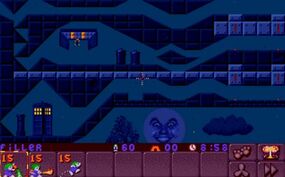Cultural references to the Doctor Who universe/1990s
From Tardis Wiki, the free Doctor Who reference
Occasionally, elements of the Doctor Who universe are referenced in the broader popular culture. This page exists to throw a spotlight on some of these casual references made in television, comics, films and other media which happened during the 1990s.
Television
- A number of Doctor Who references appeared in The Simpsons.
- "Sideshow Bob's Last Gleaming" (1995): The Fourth Doctor appears as a representative of television.
- "Bart the Fink" (1996): Comic Book Guy buys a hundred tacos from Tacomat and says "This should provide adequate sustenance for the Doctor Who marathon."
- "Mayored to the Mob" (1998): Tom Baker appears in costume at Bi-Mon-Sci-Fi-Con, along with the TARDIS.
- "Treehouse of Horror X" (1999): Comic Book Guy, under the guise of The Collector, has "Doctor Who" concealed in plastic.

Mr. Bean plays with a toy Dalek in the titular show.
- In one episode of Mr. Bean, Mr. Bean plays around with toy animals in front of a diorama of Jesus's birth. He eventually begins to bring out a toy Dalek, and pretends that it killed a toy lamb.
- Green Courage, an episode of Fox Kids' children's action series Power Rangers Lost Galaxy, featured an on-screen note claiming that a meteoroid field that had just collided with a planet was located at "ten zero eleven zero zero, by zero two from galactic zero," in the constellation of Kasterborous. In Pyramids of Mars, these coordinates are given as the location of Gallifrey.
- In the Red Dwarf episode Demons and Angels, as the crew is escaping the exploding Red Dwarf, the TARDIS can be seen in the background.
- In the third series of the 1989 show, Maid Marian and her Merry Men, "They Came From Outer Space", there is a brief audio cameo of the Daleks, who, as they always do, shout "Exterminate!".
Video games
Fallout 2

The TARDIS appears in Fallout 2.
- The TARDIS can be found in the Desert, although it disappears after a while.
- A speaking cyborg by the name of K9 is a recruitable companion. It refers to the player character as "Master", whenever it is an active member of the party.
Lemmings 2: The Tribes

The exit for one of the levels in Lemmings 2: The Tribes is the TARDIS.
- The exit for the "Shadow Tribe" level is clearly the TARDIS.
Comics
Marvel
- In Fantastic Four Vol 3 #9 (1998), Johnny Storm knows that Reed Richards got a second-hand phone booth that is bigger on the inside from his "weird 'doctor' friend". (While Johnny called it an "antique London police call box", it was drawn as a red telephone booth.)
- The Seventh Doctor previously left Death's Head on the Baxter Building, but did not meet the Fantastic Four directly (COMIC: Time Bomb!, Clobberin' Time!)
Disney Comics
- The 1999 Donald Duck comic story The Last Time Lord was a mashup spoof of Doctor Who and Star Wars where Donald was accidentally confused for the last surviving Time Lord in the universe after digging up a "laser sword" clearly standing in for a Star Wars lightsaber (the Jedi and the Time Lords being conflated in the story's mashup cosmology), and beamed up to outer space to battle a cyborg tyrant. Regeneration is alluded to, as the cyborg tyrant readily accepts Donald as his old Time Lord nemesis due to knowing that "your lot can change faces".
Prose
- In the novel High Wizardry (1990) by Diane Duane, part of the Young Wizards series, a "Mysterious Stranger" helps the protagonist out of a sticky situation. He seems oddly familiar.
- Lady Jennifer Buckingham from The War Games appears in The Bloody Red Baron (1995), the second volume of Kim Newman's crossover-intensive Anno Dracula universe. Charles Beauregard, the hero of several Anno Dracula stories, is referred to in All-Consuming Fire. One of Newman's books in the Dark Future series makes references to an alternative timeline, ultra-nationalist, pro-English version of the Doctor Who television series in which the Doctor visits famous events in English history while fighting off extraterrestrial threats to the Crown. Newman's Life's Lottery (1999), a playful exploration of the concept of alternate universes, references Inferno in some detail (and a character fantasises somewhat colourfully about Jo Grant).
- Richard Calder's Dead trilogy features numerous dark alternative time lines involved in a sex war between men and woman. At least one features a version of Doctor Who. The last scene of the final volume, Dead Things (1996), shows the young protagonist watching a scene of the "Daleks exterminating the slave girls of Skaro" on television.


